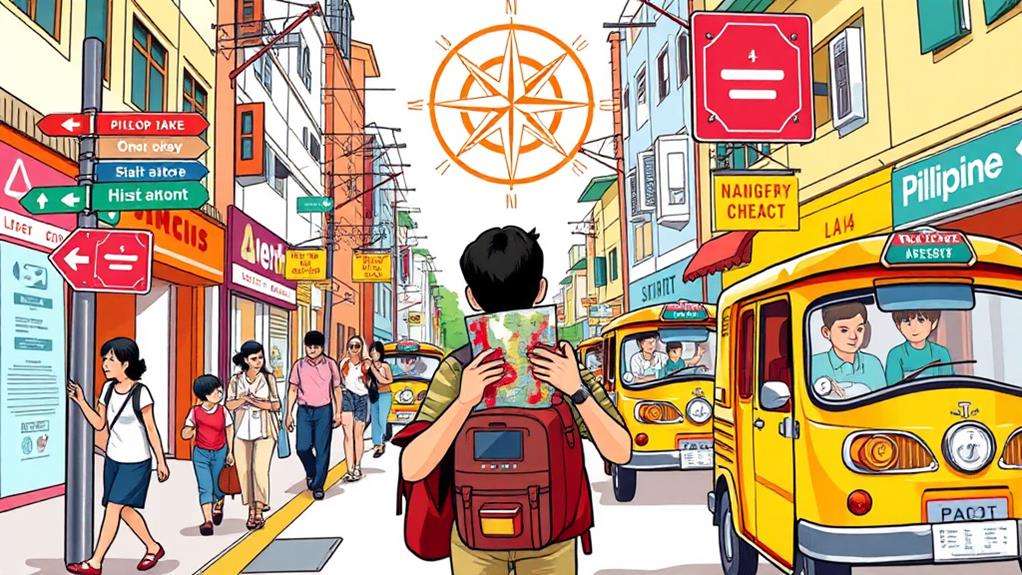Basic Greetings
When interacting with locals, it's essential to know basic Tagalog greetings. "Kamusta?" means "How are you?", and responding with "Mabuti, salamat" (Good, thank you) will show your appreciation for their concern.
Don't forget to express gratitude with "Salamat" (Thank you).
Navigating
When asking for directions, knowing the correct phrases can save you time and frustration. To ask where something is, say "Saan ang [place]?" (Where is [place]?).
Additionally, understanding "Kaliwa" (left) and "Kanan" (right) will help you navigate the streets.
Shopping
Shopping in the Philippines can be an exciting experience. To inquire about the price of an item, ask "Magkano ito?" (How much is this?).
You can also ask if there's a discount available by saying "May discount ba?" (Is there a discount?).
Emergency Situations
In case of an emergency, knowing what to say can be crucial. If you need help, shout "Tulong!" (Help!).
If you're looking for a hospital, ask "Saan ang ospital?" (Where is the hospital?).
Essential Tagalog Phrases

Mastering Essential Tagalog Phrases for a Smooth Travel Experience
When traveling to the Philippines, learning basic Tagalog phrases can significantly enhance your interactions with locals and overall experience. "Kamusta?" (How are you?) and "Salamat" (Thank you) are essential phrases to know, as they show respect and politeness.
Common courtesies like "Pakiusap" (Please) and "Walang anuman" (You're welcome) are also important to learn, as they reflect cultural respect and politeness. These phrases can make communication more pleasant and help you build connections with locals.
Navigating Unfamiliar Areas
To navigate unfamiliar areas, it's essential to know phrases like "Saan ang [place]?" (Where is [place]?). Additionally, learning "Kaliwa" (Left) and "Kanan" (Right) can help you give and follow directions.
Shopping and Budgeting
When shopping, knowing "Magkano ito?" (How much is this?) can help you budget and negotiate prices in local markets.
Emergency Situations
In case of an emergency, knowing "Tulong!" (Help!) and "Saan ang ospital?" (Where is the hospital?) can ensure your safety and assistance when needed.
Communicating With Locals
Learning the local language helps bridge the cultural gap and fosters meaningful connections with locals. By using basic phrases like "Kamusta?" (How are you?) and "Salamat po" (Thank you), you demonstrate respect and can enhance interactions with locals.
Although many Filipinos are fluent in English, attempting to speak Tagalog can foster goodwill and lead to more enriching conversations.
Showing humility and respect for the culture can lead to deeper connections. When making a mistake, saying "Pasensya na" (Have patience on me) demonstrates humility and respect for the culture.
Asking common questions like "Saan ang [place]?" (Where is [place]?) helps you navigate and explore your surroundings effectively.
Learning local expressions can lead to warmer hospitality and deeper connections. By learning these basic phrases, you show an effort to improve your language skills and connect with locals on a deeper level.
This often results in warmer hospitality and deeper connections during your travels.

Navigating the streets of the Philippines with confidence requires knowing key Tagalog phrases. When asking for directions, "Saan ang ____?" means "Where is ____?" and helps you find specific locations. For example, "Saan ang hotel?" means "Where is the hotel?"
Understanding directions is crucial when navigating streets and intersections. "Kaliwa" means "left" and "Kanan" means "right", which helps prevent getting lost. If someone gives you directions, they might say "Pumunta sa ____", which means "Go to ____", making it clear where you need to head.
Determining the distance to your destination is also important. When you ask "Malapit na ba?", it means "Is it nearby?", giving you an idea of how far you're from your destination.
Additionally, "Diretso" means "straight", so if someone tells you to go straight, you'll know which direction to follow.
Mastering these essential Tagalog words and phrases enables you to navigate the streets of the Philippines with ease and get to your desired destination without hassle.
Shopping and Dining
When shopping at Filipino markets, speaking Tagalog can help you navigate prices and negotiate deals. "Magkano ito?" (How much is this?) is a crucial phrase to ask vendors about prices.
Additionally, asking "May discount ba?" (Is there a discount?) can help you score better deals and stay within your budget.
When dining out, expressing enjoyment with "Masarap!" (Delicious!) can encourage local chefs and restaurant staff.
To customize your meal, ask "Puwede bang magkaiba ang order?" (Can the order be different?).
Inquiring about the specialty of the house with "Ano ang espesyalidad?" (What is the specialty?) can help you discover local dishes highly recommended by the staff.
After a meal, politely thank the host or server with "Salamat sa pagkain" (Thank you for the food) to reinforce positive dining etiquette.
What Are the Most Important Tagalog Phrases for Travelers to Learn?
When visiting the Philippines, learning simple tagalog phrases is essential for travelers. Greetings like “Magandang araw” (Good day) and courteous expressions like “Salamat” (Thank you) or “Paumanhin” (Sorry) can make interactions smoother. These basic phrases help bridge language gaps and show respect for the local culture, enhancing your travel experience.
Emergency Situations

Emergency Situations in Tagalog
When traveling in the Philippines, knowing basic Tagalog phrases can be crucial in emergency situations. Tulong! (Help!) is a vital phrase to shout in general emergency situations to grab attention quickly.
If you require medical assistance, saying Kailangan ng doktor (Need a doctor) clearly conveys your need. To find medical facilities, ask Nasaan ang ospital? (Where is the hospital?) to get immediate directions.
In specific emergency situations, knowing additional phrases can help. For example, if there's a fire, shout May sunog! (There is a fire!) to alert others. If you're lost, say Nawawala ako (I am lost) to get help.
Frequently Asked Questions
What Is the Tagalog of Travelers?
Manlalakbay is the Tagalog word for travelers.
This term originates from the root word "lakbay," which means to travel.
Understanding essential phrases like manlalakbay helps connect with locals and appreciate their culture during your Philippine adventure.
What Is the Tagalog of Travels?
The Tagalog word for "travels" is paglalakbay. This word refers to the act of journeying from one place to another.
Mastering this travel vocabulary is essential for navigating the Philippines. For instance, knowing the phrase "Saan ang terminal?" (Where is the terminal?) can help you find your way around.
Understanding the concept of pamasahe (fare) is also crucial when budgeting for trips.
What Is the Easiest Filipino Word?
The Easiest Filipino Word to Learn is "Po"
The easiest Filipino word to learn is "po", a marker of respect used in conversations, especially when speaking to elders. This word is essential in Filipino culture, and mastering it will help you navigate everyday conversations.
Understanding the Use of "Po"
When used in a sentence, "po" is added to the end of a phrase to show respect, similar to saying "sir" or "ma'am" in English. For example, "Salamat po" means "Thank you, sir/ma'am."
By incorporating "po" into your language skills, you'll demonstrate respect and appreciation for the Filipino culture.
Why "Po" is Important
Learning "po" is a great starting point for understanding common expressions, travel etiquette, and cultural insights.
It's a fundamental word that will help you build stronger relationships with locals and make your travel experiences more enjoyable and authentic.
What's a Common Filipino Saying?
Filipino proverbs are an integral part of daily life, offering wisdom and cultural insights. These expressions showcase the values of hard work, respect, and community.
For instance, "Kapag may tiyaga, may nilaga" translates to "perseverance yields rewards," emphasizing the importance of hard work and dedication. Another example is "Bato-bato sa langit, ang tamaan huwag magalit," which means "addressing someone indirectly," highlighting the value of respect in communication.
As you explore the Philippines, you'll encounter various local idioms, hospitality sayings, and food-related expressions. These expressions will enrich your experience and provide a deeper understanding of the country's rich cultural heritage.